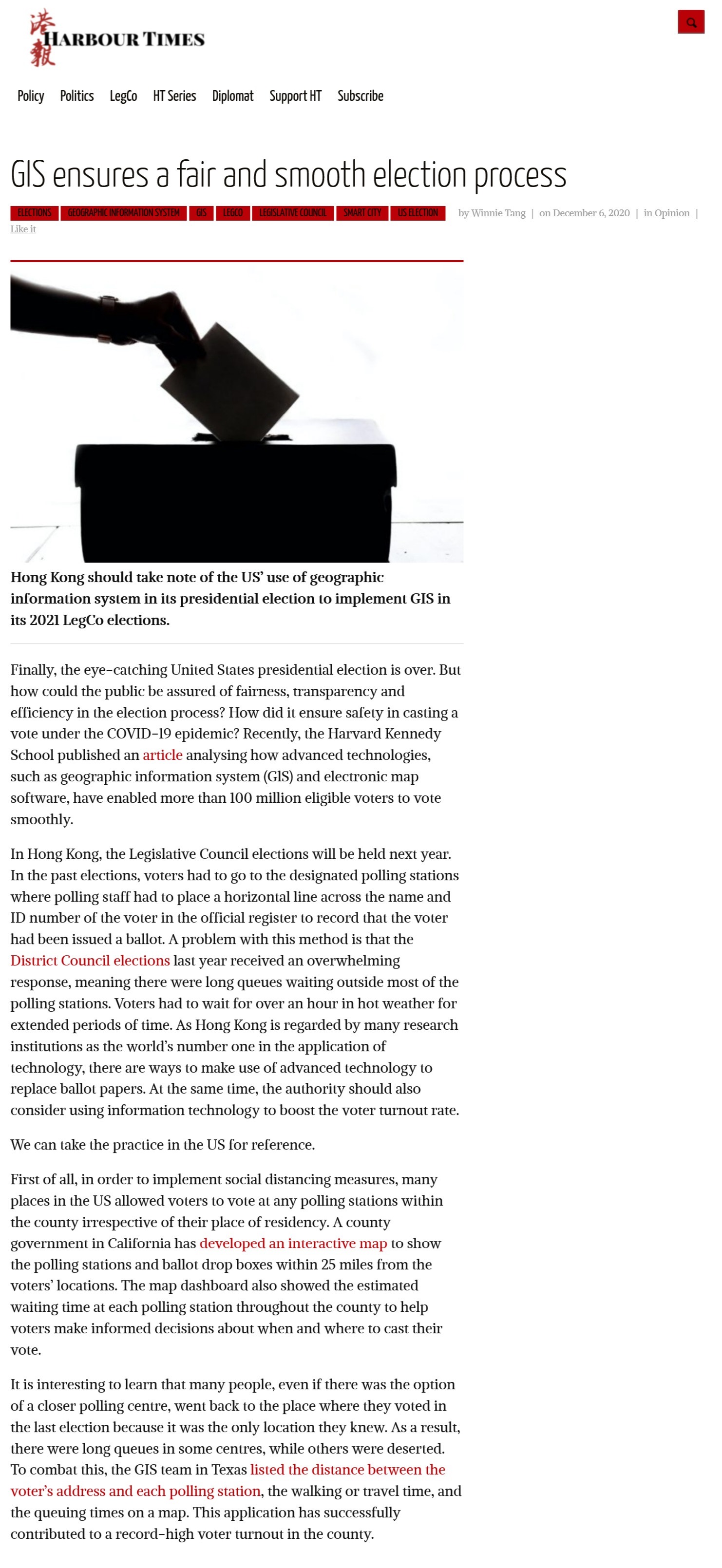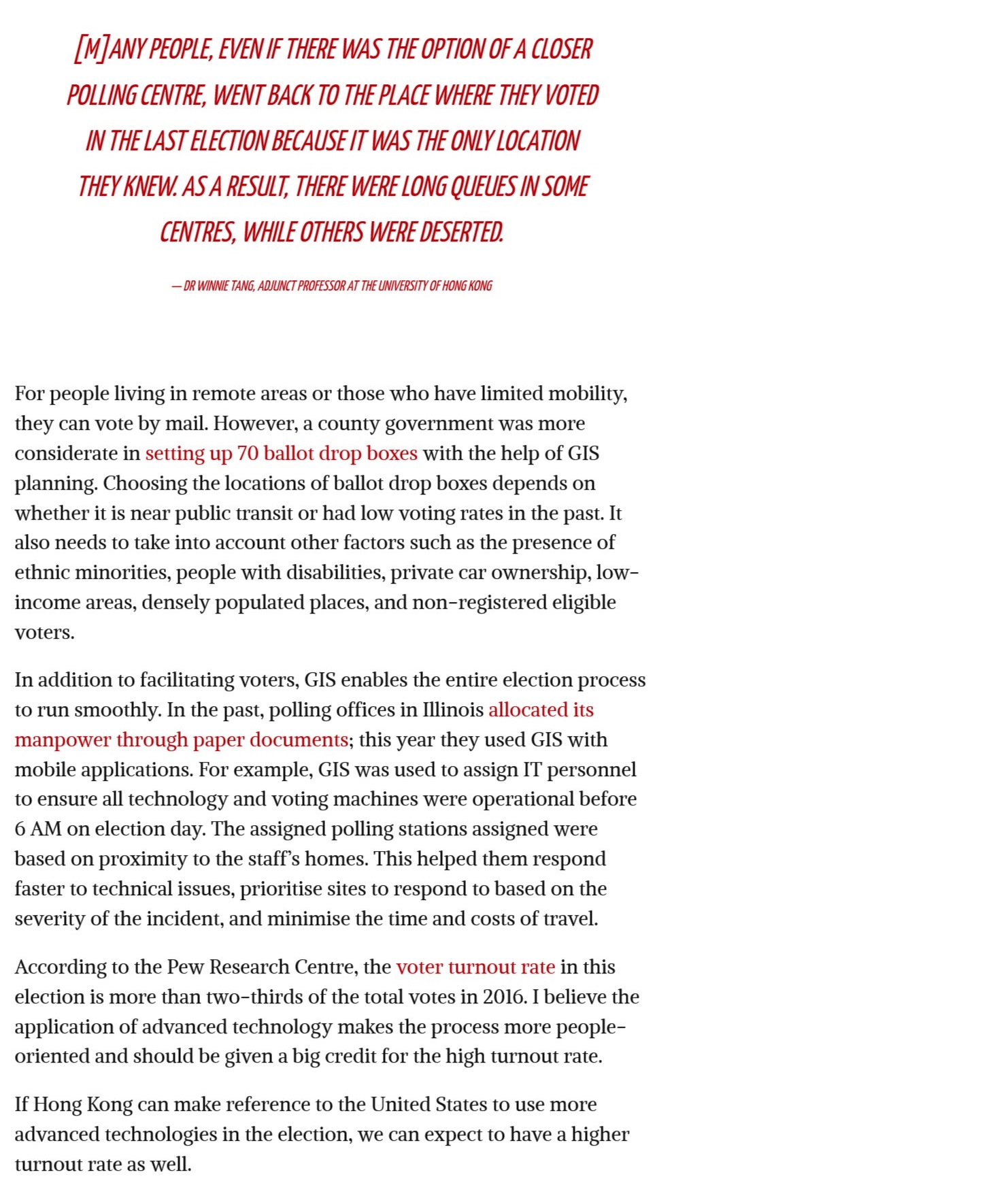網上版請按此


GIS ensures a fair and smooth election process
Finally, the eye-catching United States presidential election is over. But how could the public be assured of fairness, transparency and efficiency in the election process? How did it ensure safety in casting a vote under the COVID-19 epidemic? Recently, the Harvard Kennedy School published an article analysing how advanced technologies, such as geographic information system (GlS) and electronic map software, have enabled more than 100 million eligible voters to vote smoothly.
In Hong Kong, the Legislative Council elections will be held next year. In the past elections, voters had to go to the designated polling stations where polling staff had to place a horizontal line across the name and ID number of the voter in the official register to record that the voter had been issued a ballot. A problem with this method is that the District Council elections last year received an overwhelming response, meaning there were long queues waiting outside most of the polling stations. Voters had to wait for over an hour in hot weather for extended periods of time. As Hong Kong is regarded by many research institutions as the world’s number one in the application of technology, there are ways to make use of advanced technology to replace ballot papers. At the same time, the authority should also consider using information technology to boost the voter turnout rate.
We can take the practice in the US for reference.
First of all, in order to implement social distancing measures, many places in the US allowed voters to vote at any polling stations within the county irrespective of their place of residency. A county government in California has developed an interactive map to show the polling stations and ballot drop boxes within 25 miles from the voters' locations. The map dashboard also showed the estimated waiting time at each polling station throughout the county to help voters make informed decisions about when and where to cast their vote.
It is interesting to learn that many people, even if there was the option of a closer polling centre, went back to the place where they voted in the last election because it was the only location they knew. As a result, there were long queues in some centres, while others were deserted. To combat this, the GIS team in Texas listed the distance between the voter's address and each polling station, the walking or travel time, and the queuing times on a map. This application has successfully contributed to a record-high voter turnout in the county.
For people living in remote areas or those who have limited mobility, they can vote by mail. However, a county government was more considerate in setting up 70 ballot drop boxes with the help of GIS planning. Choosing the locations of ballot drop boxes depends on whether it is near public transit or had low voting rates in the past. It also needs to take into account other factors such as the presence of ethnic minorities, people with disabilities, private car ownership, low-income areas, densely populated places, and non-registered eligible voters.
In addition to facilitating voters, GIS enables the entire election process to run smoothly. In the past, polling offices in Illinois allocated its manpower through paper documents; this year they used GIS with mobile applications. For example, GIS was used to assign IT personnel to ensure all technology and voting machines were operational before 6 AM on election day. The assigned polling stations assigned were based on proximity to the staff’s homes. This helped them respond faster to technical issues, prioritise sites to respond to based on the severity of the incident, and minimise the time and costs of travel.
According to the Pew Research Centre, the voter turnout rate in this election is more than two-thirds of the total votes in 2016. I believe the application of advanced technology makes the process more people-oriented and should be given a big credit for the high turnout rate.
If Hong Kong can make reference to the United States to use more advanced technologies in the election, we can expect to have a higher turnout rate as well.
Dr. Winnie Tang
Adjunct Professor, Department of Geography, Faculty of Social Sciences and Faculty of Architecture, The University of Hong Kong